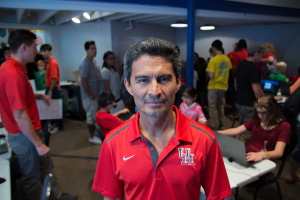Thousands of visitors flocked to the Children’s Museum Houston last Saturday to play the top selling video game Minecraft while contributing to invaluable ongoing brain research at the UH Cullen College of Engineering.
Jose Luis Contreras-Vidal, Hugh Roy and Lillie Cranz Cullen University Professor of electrical and computer engineering, was at the museum from 10 a.m. to 6 p.m. with several Cullen College students to measure the brainwaves of hundreds of children while they played Minecraft.
Contreras-Vidal, who also serves as the director of the UH Non-Invasive Brain Machine Interface Systems Laboratory, said the ultimate goal of this research is to map as much of the human brain as possible. His laboratory specializes in the development of robotic exoskeletons that can help patients with mobility impairments such as paralysis to regain control of their limbs using only the power of their thoughts.
The event was part of the “Summer of Epic Adventure – Forces Unite!” series at the Children’s Museum of Houston, sponsored by Chevron. In a collaboration with the Smithsonian Latino Center, the museum invited leading Latino scientists to speak to the children and their parents about the importance of the STEM (science, technology, engineering and mathematics) fields.
One major inspiration for conducting this research, Contreras-Vidal said, is to collect as much data on brain activity in naturally occurring settings as possible. There are plenty of small case studies looking at individuals’ brain activity in laboratory settings, but no brain researcher has ever collected data on brain activity from such large cohorts of freely-behaving subjects in natural settings.
“It’s very rare to the have the opportunity to record real data in a natural setting,” Contreras-Vidal said. “These children are playing, they are at the museum, so we are capturing brain activity in action and in context.”
Since its release in 2011, Minecraft has captivated the imaginations of children and adults all over the world. With over 54 million copies of the game sold, Minecraft is the second highest selling game of all time, beating out both Tetris (30 million copies sold) and Super Mario Bros. (40 million sold).
A Google search of the game’s title yields a litany of parental complaints about their children’s obsession with Minecraft: “If there was a 12-step program to get my 11-year-old son to stop playing Minecraft, he'd be going to meetings,” wrote Anne Brenoff in her Huffington Post column, “Breaking Up With Minecraft Is Hard To Do.”
Minecraft is a sandbox game in which players can design, build and explore imaginary worlds of their own creation. Imagine a virtual world made of Legos, then add in the fun of playing online with friends inside the world you built – a world that could otherwise exist only in your imagination. Then, there is the added fun of nighttime zombie and skeleton attacks that players must strategically build shelters from.
But despite many parental concerns about the game, some educators are using Minecraft as a platform for teaching. In fact, a growing number of teachers around the world are incorporating the game into their classrooms to help teach children creativity, engineering, leadership, teamwork and even language and math skills.
Joel Levine, a school teacher in New York City, developed a teacher dashboard and tutorial for educators to learn how to use the game in their classrooms to enhance the overall learning experience. Levine eventually established a company, MinecraftEdu, which offers special versions of the game designed specifically for classroom use.
“They’re writing poems about Minecraft,” Levine told Time.com in 2012. “In my Minecraft club for high schoolers, they’re learning how to program on their own so that they can write their own mods. They’re using their artistic skills to change the graphics. They’re learning about video production so they can make their own Minecraft videos.”
Anastasiya Kopteva, an undergraduate electrical and computer engineering student at the Cullen College who assisted with the event, said that the brainwave data will likely show heightened brain activity in children while they are playing Minecraft.
“Once we analyze the data it will likely show there’s a heightened connectivity and heightened attention span that is given to the game,” Kopteva said. “We are bringing more science to the idea that video games can actually be beneficial.”
By the end of the event, Contreras-Vidal and his team had collected data on over 400 children while they played the video game.
Watch our video of the event at https://youtu.be/SiyV8Qy59tc.
